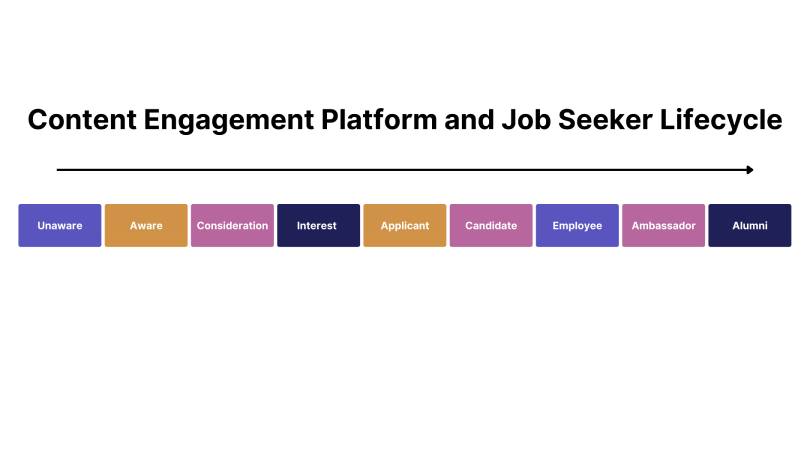Whether you rely on Tik Tok to find out what’s going on in the world or consume old-fashioned news media, “quiet quitting” is near the top of every feed. This workplace trend is not about actually quitting, but setting firm boundaries and adopting a 9-to-5 mentality – literally – about your job. In my mind, quiet quitting is good for neither employees nor companies; who wants to work at a job they don’t care about? And how can organizations achieve great things if employees are checked out?
Quiet quitting isn’t so much the problem, but rather a symptom of a much larger one: employee engagement. Most companies start thinking about engagement when new hires start their job. I believe engagement starts much earlier in the process: at the moment job seekers first see your job listing and decide to apply.
Show candidates what you’ve got
We have gotten used to applying for jobs with a few clicks, going directly from job board to application tracking system (ATS), leapfrogging past corporate careers sites. Two-click job applications don’t get job seekers engaged with your company through the careers page, and even if they did, it is a dead zone of corporate personality. To me, that’s a missed opportunity.
For the majority of companies and talent acquisition teams, career sites are composed of pages upon pages of static content, 90% of which remain the same for years. This constant sameness sends a message that all job seekers and candidates are the same and will be treated that way. It’s no wonder applicants and candidates aren’t engaged!
Here’s what I believe companies need to do: use the careers page to show candidates what you’ve got. Any medium- to large-size company already has hundreds of pieces of evergreen content such as:
- Corporate social responsibility (CSR) news
- Environmental, social and governance (ESG) initiatives
- Diversity, equity and inclusion (DE&I) programs
- Employees volunteering in their communities
- Company philanthropy
- And more.
Why not use this positive content to show
that your company offers more than just a job, it’s a great place to work?
From personalized solutions, to delightful digital experiences and effective content management, we’ve got you covered.
Find Out How to Take Your Career Site to the Next Level!
Careers site as CMS
Virtually every digital place we visit – commerce sites, news sites, podcasts, social media, professional networking sites – recognizes who we are when we go to them, offering content that will likely appeal to us. And they do it in a way that keeps us coming back, serving up a totally new content experience every few minutes.
I believe that corporate careers pages can similarly engage job seekers with new content experiences, curated to meet their interests. In this way, the career site functions as a content management system (CMS), optimizing the applicant experience and engaging job seekers by sharing the good your organization does and its values. Think about it – wouldn’t it be great to show a first-time visitor a careers page enhanced by:
- A corporate LinkedIn post about building a house with Habitat for Humanity
- Employee tweets about the house-building volunteer day
- A press release announcing sustainability achievements
- A Tik Tok video made at a diversity recruitment event
- And so forth and so on.
As the visitor moves around the careers page, clicking on industries and jobs, and possibly applying for a job, the CMS platform registers this information about the visitor, storing it to inform the content presented at future visits.
Mapping the applicant journey
Individually curated content is important because every job seeker is different – different awareness levels of your company, different personal and professional goals, and different personal and professional motivators. The most important difference is that each job seeker, applicant, and candidate is in a different place in the talent acquisition funnel. Here’s a quick lifecycle of any given job seeker and how they move through your funnel. 
Why applicant experience and engagement matter
In today’s post-pandemic work world, people seek connection with others and fulfilling work. With 45% of US workers either in hybrid or permanently remote work arrangements, it’s harder than ever to feel part of a team. Social media provides a constant feed of new information that pulls you back into the platform, helping you to stay up to date with the “team” of your life: friends, professional networks, news, and personal interests.
Careers pages can play a similar role in five of the nine stages of the talent acquisition funnel, from Awareness until Employee, helping to establish a critical connection. It’s a simple cause-and-effect; employees who feel connected with their company are more engaged, happier and more productive.
Furthermore, the burden of proof with young job seekers now sits squarely on employers; it’s up to your organization to prove that your company is worthy of these applicants. For example, nearly half (49%) of Gen Zs surveyed in 2021 by Deloitte said their personal ethics have played a role in their career choices. The survey also found that climate change and protecting the environment was the top concern for Gen Z, followed closely by unemployment and health care/disease prevention.
So what are you waiting for?
Resources are closer than you think
At this point you may be asking, “Where do I find all of this content? And how do I make it relevant to each candidate at each step in their journey?” The good news is, you’re almost undoubtedly sitting on a treasure trove of valuable content to engage job seekers, applicants and candidates – it’s just scattered around your organization and on the internet. In my next blog I’ll talk about these sources and how you can make curated content a reality on your careers page, an important component in building an authentic employer brand and nipping “quiet quitting” in the bud.
To learn about Joveo’s award-winning programmatic platform, request a demotoday. And follow us on TwitterandLinkedIn,where we’re always working to help you get the most out of your recruitment advertising.














